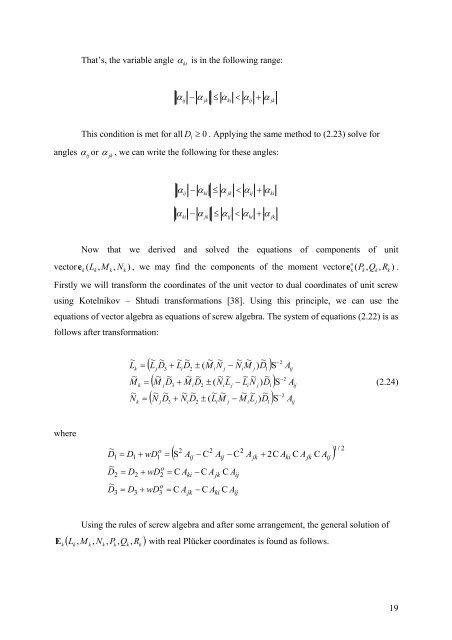Kinematic and Dynamic Analysis of Spatial Six Degree of Freedom ...
Kinematic and Dynamic Analysis of Spatial Six Degree of Freedom ...
Kinematic and Dynamic Analysis of Spatial Six Degree of Freedom ...
Create successful ePaper yourself
Turn your PDF publications into a flip-book with our unique Google optimized e-Paper software.
That’s, the variable angle α ki is in the following range:<br />
α − α ≤ α < α + α<br />
ij<br />
jk<br />
ki<br />
This condition is met for all D 0 . Applying the same method to (2.23) solve for<br />
angles αij or α jk , we can write the following for these angles:<br />
ij<br />
1 ≥<br />
α − α ≤ α < α + α<br />
ki<br />
ki<br />
α − α ≤ α < α + α<br />
jk<br />
jk<br />
ij<br />
Now that we derived <strong>and</strong> solved the equations <strong>of</strong> components <strong>of</strong> unit<br />
o<br />
vector e k ( Lk<br />
, M k , Nk<br />
) , we may find the components <strong>of</strong> the moment vector e k ( Pk<br />
, Qk<br />
, Rk<br />
) .<br />
Firstly we will transform the coordinates <strong>of</strong> the unit vector to dual coordinates <strong>of</strong> unit screw<br />
using Kotelnikov – Shtudi transformations [38]. Using this principle, we can use the<br />
equations <strong>of</strong> vector algebra as equations <strong>of</strong> screw algebra. The system <strong>of</strong> equations (2.22) is as<br />
follows after transformation:<br />
where<br />
k<br />
~<br />
D<br />
~<br />
D<br />
~<br />
D<br />
1<br />
2<br />
3<br />
= D<br />
= D<br />
~<br />
Lk<br />
=<br />
~<br />
M k =<br />
~<br />
N =<br />
k<br />
~ ~ ~ ~ ~ ~ ~ ~ ~ −2<br />
( L jD3<br />
+ LiD<br />
2 ± ( M iN<br />
j − NiM<br />
j ) D1<br />
) S Aij<br />
~ ~ ~ ~ ~ ~ ~ ~ ~ −2<br />
( M jD3<br />
+ M iD2<br />
± ( NiL<br />
j − Li<br />
N j ) D1<br />
) S A<br />
~ ~ ~ ~ ~ ~ ~ ~ ~ −2<br />
( N jD3<br />
+ NiD2<br />
± ( LiM<br />
j − M iL<br />
j ) D1<br />
) S Aij<br />
o<br />
1<br />
= D + wD<br />
1<br />
2<br />
3<br />
+ wD<br />
+ wD<br />
o<br />
2<br />
o<br />
3<br />
=<br />
ij<br />
ij<br />
ki<br />
2 2 2<br />
( S A − C A − C A + 2C<br />
A C A C A )<br />
= C A<br />
= C A<br />
ij<br />
ki<br />
jk<br />
− C A<br />
− C A<br />
jk<br />
ki<br />
ij<br />
C A<br />
C A<br />
ij<br />
ij<br />
jk<br />
jk<br />
ki<br />
jk<br />
ki<br />
ij<br />
jk<br />
1/<br />
2<br />
ij<br />
Using the rules <strong>of</strong> screw algebra <strong>and</strong> after some arrangement, the general solution <strong>of</strong><br />
( L , M , N , P , Q , R )<br />
E with real Plücker coordinates is found as follows.<br />
k<br />
k<br />
k<br />
k<br />
k<br />
k<br />
(2.24)<br />
19
















